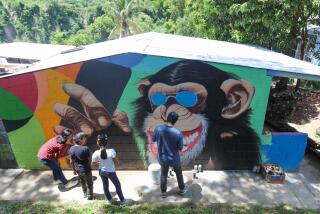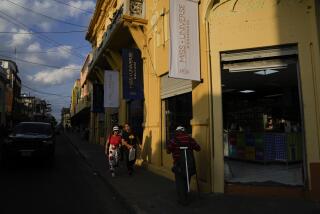El Salvador Aims for Image as Tourist Spot
- Share via
SAN SALVADOR — Passengers arriving at El Salvador’s only international airport are divided into two groups to pass through immigration: citizens and diplomats. There is no line for tourists.
“That is because we do not have a tourism mentality,” said Edgardo Suarez, who, as president of the new, government-owned Salvadoran Tourism Corp., is in charge of developing that mentality.
“We don’t know what a tourist is, much less how to treat one.”
Using a budget of $4 million from the federal government and trying to raise an equal amount from the private sector, the company this month is beginning the task of reviving a tourism industry devastated by 12 years of civil war and five years of postwar unrest.
With dramatic volcanoes and 193 miles of coastline--including what is considered some of the best surf in the Americas--El Salvador certainly has attractions for tourists.
In 1995, 235,007 visitors registered as tourists. But Suarez estimates that only about a fifth of them really were. Most were probably business travelers who wanted to avoid inquiries.
Attracting more real tourists is going to take considerable effort, Suarez said, because “what foreigners think when they hear ‘El Salvador’ is violence.”
Nor are they completely wrong, he acknowledged.
High unemployment, an inexperienced police force and easy availability of weapons left over from the war have made street crime a serious problem in El Salvador. Public safety is the biggest obstacle to tourism, Suarez said.
Safety concerns, he said, may be what motivates some airlines to discourage passengers stranded in San Salvador from seeing the city.
Bob and Marilyn Young of San Diego tried to look on the bright side when, because of delays and technical problems, their flight to the Caribbean island of Roatan was rerouted to El Salvador for a night.
“I was actually kind of excited about it because all I knew about the country was what I saw in the movie ‘Salvador,’ ” said Bob Young.
But after several hours’ delay for paperwork at the airport, passengers were herded onto a bus, shuttled to a luxury hotel in the capital and told by airline personnel to stay there, the Youngs said.
Airline officials said the paperwork was to help passengers avoid $32 in taxes and fees.
Instructions not to leave the hotel were “a misunderstanding,” said TACA Airlines spokesman Jose Lorenzana.
However, other travelers have reported similar experiences in El Salvador.
Suarez hopes that visitors will not have to depend on airlines for tourist information much longer.
Beginning in May, clearly identified agents from his organization will be posted at the airport and in hotel lobbies to suggest restaurants and other attractions, he said.
In addition, officials working with the National Civilian Police plan to create “security corridors” in tourist areas, where plainclothes police will patrol.
Another challenge facing the tourism corporation is to develop tourist-class accommodations outside the capital. El Salvador has only one major beach resort. The country also needs more highway signs and street signs.
Suarez predicts that new hotels, new signs and a new consciousness will be ready in a year or two.
He even has in mind an attraction for people who equate El Salvador with war.
The tourism corporation plans “War and Peace Tours” of the major battle sites and underground guerrilla settlements of the civil war. The tours will feature helicopter rides, horseback treks and river rafting.
(BEGIN TEXT OF INFOBOX / INFOGRAPHIC)
Slow to Recover
El Salvador’s tourism industry has not recovered from 12 years of civil war that ended five years ago this month.
‘80: Civil war begins
‘84: Peace talks attempted
‘92: Peace agreement signed
‘94: Presidential elections
More to Read
Sign up for The Wild
We’ll help you find the best places to hike, bike and run, as well as the perfect silent spots for meditation and yoga.
You may occasionally receive promotional content from the Los Angeles Times.






